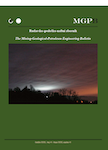Stability Analysis of Tunnel Support System Using Numerical and Intelligent Simulations (Case Study: Kouhin Tunnel of Qazvin-Rasht Railway)
DOI:
https://doi.org/10.17794/rgn.2019.2.1Abstract
According to underground constructions development and their highly cost process, accurate assessment and prevention of probable risks are significant. Different methods have been developed to assess underground constructions. In this paper, it is aim to develop a new soft computing model to evaluate the tunnel support system. Firstly, numerical analysis was performed using the explicit finite difference model by FLAC2D software to excavate sequence model and support system installation. Design loads including the axial force, moment, and shear force were calculated for some important points of support system including the crown, middle of bottom and the side walls. In order to stability analysis of support system, the section points were evaluated into 3 clusters by Artificial Bee Colony as meta-heuristic algorithm and K-means algorithm in Matlab software. The results of clustering were compared by safety factor of support system. The results indicated that the section points that are in cluster 1 have lower safety factor than cluster 3 and 2, respectively. It concluded that the Artificial Bee Colony can be reliability used to initial assessment of tunnel support systems based on axial force, moment, and shear force.
Downloads
Published
How to Cite
Issue
Section
License
Copyright (c) 2018 authors and journal

This work is licensed under a Creative Commons Attribution 4.0 International License.
Creative Commons-BY
Authors who publish with this journal agree to the following terms:
In agreeing this form, you certify that:
- You read the ethical codex of the RGN zbornik available at journal web.
- You submitted work is your original work, and has not previously been published and does not include any form of plagiarism.
- You own copyright in the submitted work, and are therefore permitted to assign the licence to publish to RGN zbornik.
- Your submitted work contains no violation of any existing copyright or other third party right or any material of an obscene, libellous or otherwise unlawful nature.
- You have obtained permission for and acknowledged the source of any illustrations, diagrams or other material included in the work of which you are not the copyright owner.
- You have taken due care to ensure the accuracy of the work, and that, to the best of your knowledge, there are no false statements made within it.
- All co-authors of this submitted work are aware of, and in agreement with, the terms of this licence and that the submitted manuscript has been approved by these authors.
Publication licence
You retain copyright in your submitted work, according to journal license policy (CC-BY). By signing this form you agree that RGN zbornik may publish it under the publication licence. In summary the licence allows the following:
Anyone is free:
- To copy, distribute, display, and perform the work.
- To make derivative works.
Under the following conditions:
- The original author must always be given credit.
- The work may not be used for commercial purposes.
- If the work is altered, transformed, or built upon, the resulting work may only be distributed under a licence identical to this one.
Exceptions to the licence
In addition to publishing the work printed under the above licence, RGN zbornik will also enable the work to be visible online.
The journal editorial can change the licence rules anytime but it cannot retroactively restrict author(s) rights.


